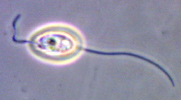Ploeotia is a genus of heterotrophic flagellates belonging to the Euglenida, a diverse group of flagellated protists in the phylum Euglenozoa. Species of Ploeotia are composed of rigid cells exhibiting two flagella. The genus was described by Félix Dujardin in 1841.
| Ploeotia | |
|---|---|

| |
| Light micrograph of Ploeotia showing anterior (left) and posterior (right) flagella | |
| Scientific classification | |
| Domain: | Eukaryota |
| Phylum: | Euglenozoa |
| Class: | Euglenida |
| Clade: | Alistosa |
| Family: | Ploeotiidae |
| Genus: | Ploeotia Dujardin, 1841[1] |
| Type species | |
| Ploeotia vitrea Dujardin, 1841[1]
| |
Description
editPloeotia is a genus of flagellates, single-celled eukaryotes or protists that move using flagella. They have two flagella of different lengths. Like all euglenids, cells of Ploeotia have a pellicle underneath the cell membrane composed of spiralling protein stripes. In some euglenids, such as euglenophytes and peranemids, the number of stripes is high enough that the cells are very flexible and can exhibit a unique movement knowwn as metaboly. In more basal euglenids, such as petalonemids and ploeotids (including Ploeotia), the number of stripes is low (10 or 12), which makes the cells significantly more rigid.[2]
Taxonomic history
editThe genus Ploeotia was described by French protozoologist Dujardin in his 1841 work Histoire naturelle des zoophytes.[1] In 2016, American protozoologist Thomas Cavalier-Smith created the family Ploeotiidae to include only Ploeotia, within the order Ploeotiida and class Ploeotarea which also included the genus Lentomonas. At the same time, the closely related genus Serpenomonas was transferred into another monotypic family, Serpenomonadidae, within a completely different class.[3]
All of these higher taxa were reinterpreted in 2019, when phylogenetic analyses demonstrated that Ploeotia and Serpenomonas were more closely related to each other than to the rest of euglenids, including Lentomonas. Consequently, the class Ploeotarea and order Ploeotiida were deemed polyphyletic, and the family Ploeotiidae was modified to include Ploeotia and Serpenomonas.[2] Both genera belong to a basal clade of euglenids known as Alistosa, along with other genera such as Lentomonas, Decastava and Keelungia.[4][5] The following cladogram shows the phylogenetic placement of Ploeotia within euglenids:[5][6]
References
edit- ^ a b c Félix Dujardin (1841). Histoire naturelle des zoophytes. Infusoires, comprenant la physiologie et la classificatin de ces animaux, et la manière de les étudier à l'aide du microscope [Natural history of zoophytes. Infusoria, understanding the physiology and classification of these animals, and how to study them using the microscope] (in French). Paris: Librairie encyclopédique de Roret. pp. 345–346. doi:10.5962/bhl.title.10127. OCLC 4356503.
- ^ a b Gordon Lax; Won Je Lee; Yana Eglit; Alastair Geoffrey Brinley Simpson (23 March 2019). "Ploeotids Represent Much of the Phylogenetic Diversity of Euglenids". Protist. 170 (2): 233–257. doi:10.1016/J.PROTIS.2019.03.001. ISSN 1434-4610. PMID 31102975. Wikidata Q92132357.
- ^ Thomas Cavalier-Smith (15 September 2016). "Higher classification and phylogeny of Euglenozoa". European Journal of Protistology. 56: 250–276. doi:10.1016/J.EJOP.2016.09.003. ISSN 0932-4739. PMID 27889663. Wikidata Q39151632.
- ^ Gordon Lax; Alastair G. B. Simpson (16 August 2020). "The Molecular Diversity of Phagotrophic Euglenids Examined Using Single-cell Methods". Protist. 171 (5): 125757. doi:10.1016/J.PROTIS.2020.125757. ISSN 1434-4610. PMID 33126020. Wikidata Q101127864.
- ^ a b G. Lax; M. Kolisko; Y. Eglit; et al. (June 2021). "Multigene phylogenetics of euglenids based on single-cell transcriptomics of diverse phagotrophs". Molecular Phylogenetics and Evolution. 159: 107088. doi:10.1016/J.YMPEV.2021.107088. ISSN 1055-7903. Wikidata Q110667805.
- ^ Gordon Lax; Anna Cho; Patrick J. Keeling (30 March 2023). "Phylogenomics of novel ploeotid taxa contribute to the backbone of the euglenid tree". Journal of Eukaryotic Microbiology. 70 (4). doi:10.1111/JEU.12973. ISSN 1066-5234. Wikidata Q123348233.